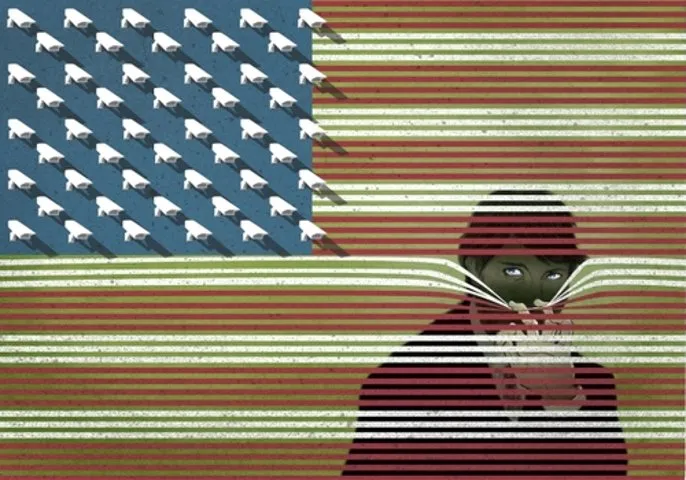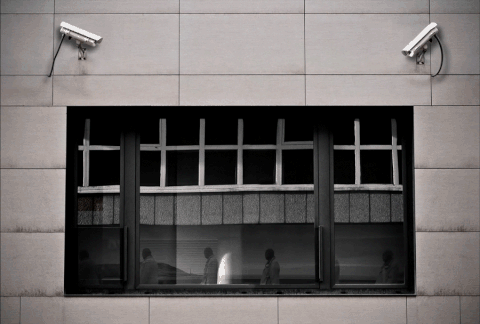Under Observation: The Panopticon Effect.

British philosopher Jeremy Bentham proposed erecting a hotel, or a jail, in circular form—with a watchman at the center and the resident guests on the periphery. In this way, one person could keep a careful eye on everyone else. Bentham called this building the Panopticon, and the reaction of those under observation came to be known as the Panopticon effect. In this lecture, you’ll learn about the effects—both positive and negative—that observation has on our conduct. You’ll also learn about the effects of social behavior when it is anonymous. Furthermore, you’ll learn about the effects that observation has on the watchman.
Observation and Human Behavior
● Most Western governments don’t take prurient interest in their citizens’ private lives, and a wide range of safeguards normally is erected to maintain this healthy barrier. But social science tells us that harm can happen even when the government is not actively looking over our shoulders. There is a self-editing effect that arises from the perception of scrutiny.
● There might not be a great deal of self-editing among many people, but sometimes those who lead lives on the edges of social convention— politically, culturally, or behaviorally—might edit their behavior out of a concern for how their actions will be perceived.
● But the observer effect is as real in social structures as it is in physics. That’s why schools have proctors in exam rooms. The very specter of surveillance and its effects on behavior can be characterized by some as a cognizable harm to their liberty.
● In the 1950s—at the height of anti-Communist feelings during the Cold War—government employees and professors in Washington DC came under closer scrutiny. As a result, many of them withdrew from nongovernmental organizations, cancelled subscriptions, declined to participate in petition drives, and became more cautious in their conversations with strangers. This reflects, on a smaller scale, the same reaction to surveillance as seen in other nations where surveillance is overt and pervasive.
● But the observer effect is more widespread than what arises from gross and intrusive surveillance. One study by the Australian academic Shane Dawson, who specializes in social network analysis, looked at how institutional surveillance technologies affected student behavior in educational environments. Dawson found that the students’ Internetbrowsing behaviors, as well as the range of topics they discussed in online forums and the writing styles they employed, were influenced by the degree to which they understood their activities to be under surveillance by the educational institution.
● It is worth noting that the adverse effects of observation are not limited to government surveillance. In our evermore-transparent society, which is galvanized by the proliferation of social media, the malign effects of public observation are often on display, most notably through acts of public shaming.
● The British journalist Jon Ronson cataloged some aberrant instances in his book, So You’ve Been Publicly Shamed. He tells the story, for example, of Justine Sacco, a New Yorker who tweeted an offensive joke to her followers just before boarding a long flight to South Africa. Her tweet was retweeted and went viral. She lost her job and suffered months of online harassment—probably much harsher punishment than one very poorly thought-out tweet deserved.
● Alice Marwick, a postdoctoral researcher in social media at Microsoft, calls this type of public monitoring “social surveillance.” She has documented how it has behavioral-modification effects on teenagers who have profiles on social networks. Because of the observer effect, these teens consciously shape their external image and modify their online behavior—mostly to satisfy the social pressure of other teens. Some conformity is the inevitable result. We also see more surreptitious social surveillance (Facebook stalking).
● Our instinct to observe and judge others is a dark side of the Panopticon, no matter who wields the watchers’ spectacles. These public shamings, distributed via social media, are commentaries that we hope never to read about ourselves. But, certainly, everyone has something to hide.
● The watchman’s observing eye can also, of course, have positive effects. One notable place we have seen this phenomenon is in the actions of corporations subject to public scrutiny under the law. So-called rightto-know laws often mandate that companies disclose sensitive details about their operations—how much of a pollutant, for example, they discharge into a local river. These laws have had the salutary effect of driving pollution reduction without mandates.
● This demonstrates that public observation—a form of mass surveillance—can have a positive effect on societally undesirable behavior. The same goes for government surveillance of the citizenry. Sometimes, governments can produce social benefits with surveillance and data collection.
● In 2014, Ebola raged in Western Africa. Doctors fought to stem the flood, aided by big data. They used mobile phones owned by West Africans that were equipped with geolocation capabilities—that is, the ability to broadcast the unit’s geographic location. Using voice and text data, the authorities tracked population movements in the region and figured out the best places to set up treatment centers. They also identified which areas to quarantine.
Anonymity and Human Behavior
● Some evidence suggests that, in the absence of a watchful eye, anonymity fosters aberrantly bad behavior. But in other ways, anonymity allows for positive social engagement.

● We commonly recognize that anonymous actors are ruder and more abusive than those we can identify. The most common place we see this is in the cyber domain, where anonymity is common. This is sometimes known as the online disinhibition effect. Social norms that are present in face-to-face conversations seem to disappear in the cyber world.
● We aren’t sure exactly where this lack of inhibition comes from. To be sure, some of it arises from anonymity.
● Some also stems from the related, yet distinct, problem of invisibility: If you can’t see me, then you can’t read the social clues I’m sending, and if I can’t see you, then I can’t know who you are, so I can’t relate to you.
● A third cause is sometimes called asynchronicity: We aren’t talking to each other in the same place at the same time, which makes it easy to leave a message that is volatile and inflammatory, and then just disappear.
● Still other sources of the lack of inhibition might be the idea of fantasy; many conversations seem less real when they take place in the cyber domain. Some people see it as a second world, where life is just a game, and the regular rules of conduct (i.e., obligations to honesty or kindness) don’t apply.
● The sad rise of cyberbullying is a particularly unfortunate example of such harmful behavior. Even though the conduct is increasingly subject to criminalization, it continues. Anonymity makes it more difficult to identify bad actors, so they continue to act badly.
● Professors Keith Wilcox of Columbia University and Andrew T. Stephen of the University of Pittsburgh found that in social networks that allow for anonymity—as in the use of pseudonymous screen names—people tend to present a positive self-view of themselves to others. This leads to increases in self-esteem, albeit while also tending to reduce selfcontrol.
● This is a different way of looking at the same anonymity issue. The conclusion of Wilcox and Stephen is pretty positive. In their view, people post comments on Facebook that they would probably never say aloud—not because they are mean, but because they feel empowered.
Psychological Effects of Observers
● There are psychological effects that arise specifically from being in a position to watch. In the movie The Lives of Others, about East Germany’s Stasi system of state surveillance, a crucial transformation takes place in the psyche of the watcher, Gerd Weisler. At the start of the movie, he is a loyal party spy. By the end, the intrusiveness of his own watching and listening has changed him so much that he betrays the state Communist party.
● Although one might hope to imagine that the psychological effect of being a watcher is always so salutary, sadly we know that isn’t the case. Among the best recent evidence for the bleak downside is the stress registered by some surveillance drone operators, whom we can think of as contemporary, technology-empowered observers.
● For years, psychologists thought that post-traumatic stress disorder (PTSD) arose from “fear conditioning”—that is, from the lasting psychological ramifications of mortal terror. Drone pilots typically don’t experience that fear. They are physically safe, far away from the battlefield.
● But some suffer from PTSD, nevertheless—not because of any physical violence inflicted on them but, rather, due to their sensitivity to the violence they witness inflicted on others, or perhaps even reflecting the watchman’s failure, or inability, to do anything about it.
● Not all observers suffer equally. Many, it seems, are readily able to disassociate themselves from what they are seeing and doing. Somehow, for example, many of the guards at Nazi concentration camps during World War II were able to internalize the horrific depredations they administered.
● The lead Nazi exterminator, Adolph Eichmann, and others like him, expressed no outward effect from observing and orchestrating the greatest atrocities. It is a result that most people find extremely puzzling and very disturbing.
● As with most issues of psychology, the overall sum of evidence is somewhat inconclusive. But it is fair to say that the evidence confirms our instincts. We certainly see ways in which observation can enforce good behavior, but it also creates incentives for excess.
Questions to Consider
If you had taken the Milgram test, how would you have reacted?
Have you ever used an anonymizing feature on the web? Why? How do you react when someone else uses that feature and keeps their identity from you?
